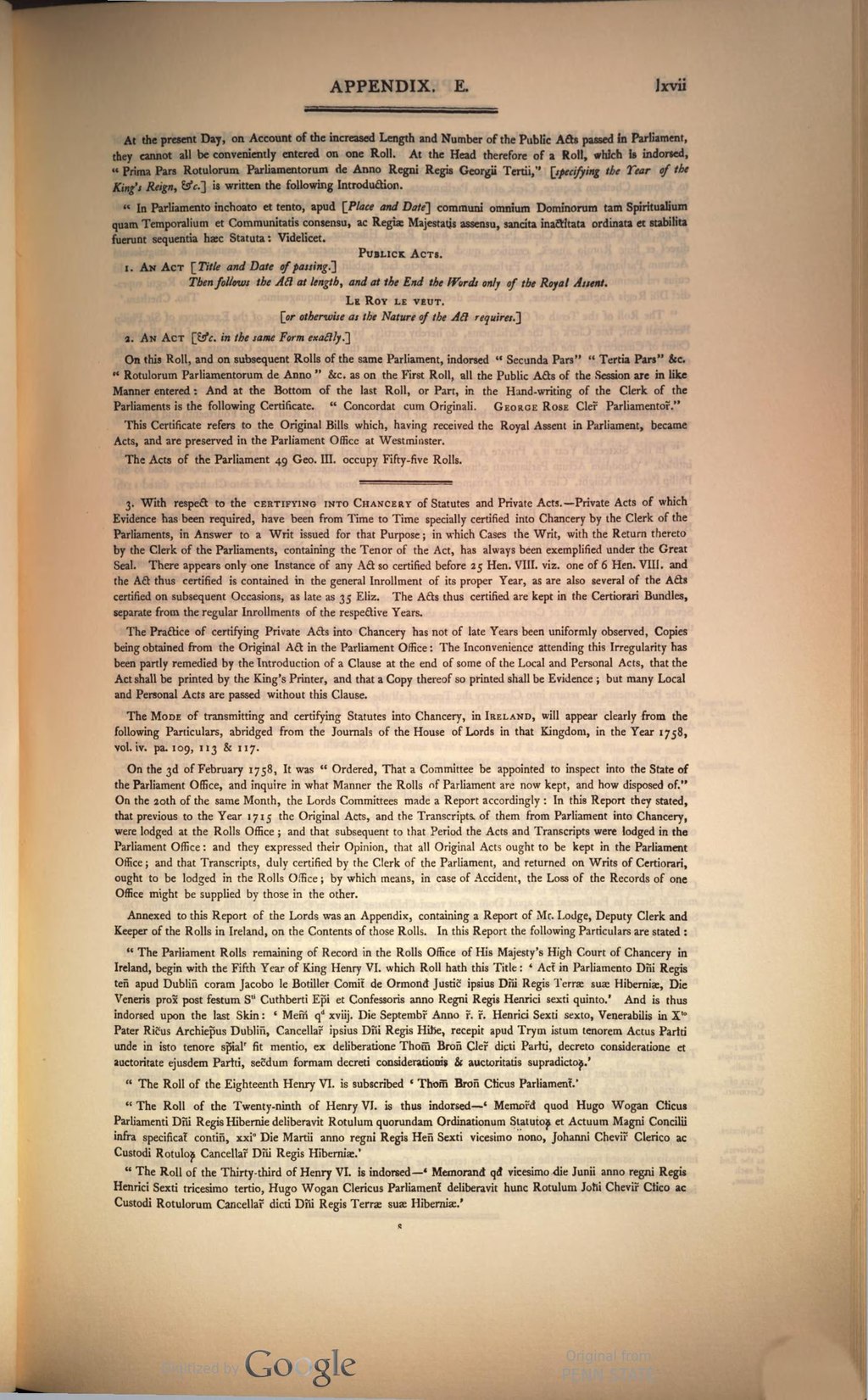At the present Day, on Account of the increased Length and Number of the Public Acts passed in Parliament, they cannot all be conveniently entered on one Roll. At the Head therefore of a Roll, which is indorsed, “Prima Pars Rotulorum Parliamentorum de Anno Regni Regis Georgii Tertii,” [specifying the Year of the King’s Reign, &c.] is written the following Introduction.
“In Parliamento inchoato et tento, apud [Place and Date] communi omnium Dominorum tam Spiritualium quam Temporalium et Communitatis consensu, ac Regiæ Majestatis assensu, sancita inactitata ordinata et stabilita fuerunt sequentia hæc Statuta: Videlicet.
Publick Acts. | ||
| 1. | An Act | [Title and Date of passing.] |
| Then follows the Act at length, and at the End the Words only of the Royal Assent. | ||
| Le Roy le veut. [or otherwise as the Nature of the Act requires. | ||
| 2. | An Act | [&c. in the same Form exactly.] |
On this Roll, and on subsequent Rolls of the same Parliament, indorsed “Secunda Pars” “Tertia Pars” &c. “Rotulorum Parliamentorum de Anno” &c. as on the First Roll, all the Public Acts of the Session are in like Manner entered: And at the Bottom of the last Roll, or Part, in the Hand-writing of the Clerk of the Parliaments is the following Certificate. “Concordat cum Originali. George Rose Cler̃ Parliamentor̃.”
This Certificate refers to the Original Bills which, having received the Royal Assent in Parliament, became Acts, and are preserved in the Parliament Office at Westminster.
The Acts of the Parliament 49 Geo. III. occupy Fifty-five Rolls.
3. With respect to the certifying into Chancery of Statutes and Private Acts.—Private Acts of which Evidence has been required, have been from Time to Time specially certified into Chancery by the Clerk of the Parliaments, in Answer to a Writ issued for that Purpose; in which Cases the Writ, with the Return thereto by the Clerk of the Parliaments, containing the Tenor of the Act, has always been exemplified under the Great Seal. There appears only one Instance of any Act so certified before 25 Hen. VIII. viz. one of 6 Hen. VIII. and the Act thus certified is contained in the general Inrollment of its proper Year, as are also several of the Acts certified on subsequent Occasions, as late as 35 Eliz. The Acts thus certified are kept in the Certiorari Bundles, separate from the regular Inrollments of the respective Years.
The Practice of certifying Private Acts into Chancery has not of late Years been uniformly observed, Copies being obtained from the Original Act in the Parliament Office: The Inconvenience attending this Irregularity has been partly remedied by the Introduction of a Clause at the end of some of the Local and Personal Acts, that the Act shall be printed by the King’s Printer, and that a Copy thereof so printed shall be Evidence; but many Local and Personal Acts are passed without this Clause.
The Mode of transmitting and certifying Statutes into Chancery, in Ireland, will appear clearly from the following Particulars, abridged from the Journals of the House of Lords in that Kingdom, in the Year 1758, vol. iv. pa. 109, 113 & 117.
On the 3d of February 1758, It was “Ordered, That a Committee be appointed to inspect into the State of the Parliament Office, and inquire in what Manner the Rolls of Parliament are now kept, and how disposed of.” On the 20th of the same Month, the Lords Committees made a Report accordingly: In this Report they stated, that previous to the Year 1715 the Original Acts, and the Transcripts of them from Parliament into Chancery, were lodged at the Rolls Office; and that subsequent to that Period the Acts and Transcripts were lodged in the Parliament Office: and they expressed their Opinion, that all Original Acts ought to be kept in the Parliament Office; and that Transcripts, duly certified by the Clerk of the Parliament, and returned on Writs of Certiorari, ought to be lodged in the Rolls Office; by which means, in case of Accident, the Loss of the Records of one Office might be supplied by those in the other.
Annexed to this Report of the Lords was an Appendix, containing a Report of Mr. Lodge, Deputy Clerk and Keeper of the Rolls in Ireland, on the Contents of those Rolls. In this Report the following Particulars are stated:
“The Parliament Rolls remaining of Record in the Rolls Office of His Majesty’s High Court of Chancery in Ireland, begin with the Fifth Year of King Henry VI. which Roll hath this Title: ‘Act̃ in Parliamento Dñi Regis ten̄ apud Dublin̄ coram Jacobo le Botiller Comit̃ de Ormond̵ Justic̃ ipsius Dñi Regis Terræ suæ Hiberniæ, Die Veneris prox̃ post festum Sti Cuthberti Ep̃i et Confessoris anno Regni Regis Henrici sexti quinto.’ And is thus indorsed upon the last Skin: ‘Mem̃ qd xviij. Die Septembr̃ Anno r̃. r̃. Henrici Sexti sexto, Venerabilis in Xto Pater Ric̃us Archiep̃us Dublin̄, Cancellar̃ ipsius Dñi Regis Hib̴e, recepit apud Trym istum tenorem Actus Parl̵ti unde in isto tenore sp̃ialr fit mentio, ex deliberatione Thom̄ Bron̄ Cler̃ dicti Parl̵ti, decreto consideratione et auctoritate ejusdem Parl̵ti, sec̃dum formam decreti considerationis & auctoritatis supradictoꝝ.’
“The Roll of the Eighteenth Henry VI. is subscribed ‘Thom̄ Bron̄ Cl̵icus Parliament̃.’
“The Roll of the Twenty-ninth of Henry VI. is thus indorsed—‘Memor̃d̵ quod Hugo Wogan Cl̵icus Parliamenti Dñi Regis Hibernie deliberavit Rotulum quorundam Ordinationum Statutoꝝ et Actuum Magni Concilii infra specificat̃ contin̄, xxi° Die Martii anno regni Regis Hen̄ Sexti vicesimo nono, Johanni Chevir̃ Clerico ac Custodi Rotuloꝝ Cancellar̃ Dñi Regis Hiberniæ.’
“The Roll of the Thirty-third of Henry VI. is indorsed—‘Memorand̵ qd̵ vicesimo die Junii anno regni Regis Henrici Sexti tricesimo tertio, Hugo Wogan Clericus Parliament̃ deliberavit hunc Rotulum Joh̴i Chevir̃ Cl̵ico ac Custodi Rotulorum Cancellar̃ dicti Dñi Regis Terræ suæ Hiberniæ.’
s
